
Cobblestones. It’s what the Paris Roubaix is all about.
The message in my inbox was like something from the French Resistance. An ordinance map of a town in northern France with a key intersection circled in red. There was a simple message to meet on the outskirts of town. “At 1430 we begin our work…”
The rendezvous was on roadside near the town of Orchies, about 10 km from the French-Belgian border. It’s a part of France steeped in the history of war. The fields of Flanders are just to the north, and the battlefields of the Somme to the south.
But this was not part of some military campaign. Instead, I was meeting a group of men who were fighting for something different – to keep alive the history and traditions of one of the great monuments of cycling, the Paris Roubaix.
The Paris-Roubaix is a one-day bike race in northern France, held every year in early April. It is one of cycling’s oldest races, and has been run in various formats since 1896. In the early days it started in Paris, but it now starts about 85 km north east at Compiègne, finishing as it has always done in the velodrome of the industrial town of Roubaix, some 260 km later.
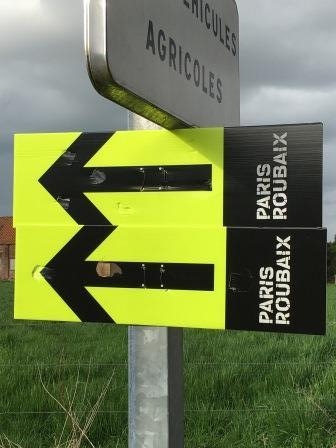
Roubaix? This way
The race’s defining feature is that in its second half it heads over sections of cobblestoned road that are little more than rough farm tracks. These cobbles are not the precise dainty cubes found in the roadways of European capitals. Instead, they are little more than roughly shaped granite rocks, each about the size of a small melon. Add in some mud, rain, and a mirror-slick finish from the passing tractor tyres and the sectors of pavé are uncomfortable at best, and downright dangerous in the heat of a professional bike race.
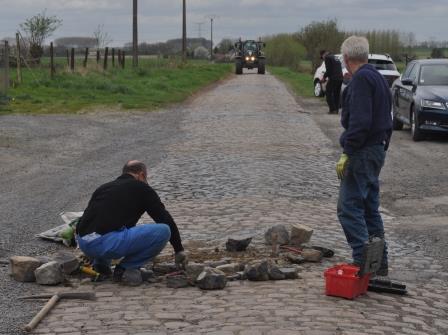
It’s true! they really are farm tracks
To get a sense of what it’s all about, you should – if you have a spare 20 minutes or so – check out a couple of YouTube videos about the race. They follow the fortunes of the Orica-GreenEdge pro team in the 2014 and 2016 editions of the race. I go back and watch them from time to time. If you can get through both without a bit of a tear in your eye and an uplifting sense of the triumph of human endeavour, you’re made of sterner stuff than me. You pick up this race and squeeze it and it drips mud, sweat and history.
I reached Orchies ahead of schedule, so had time for lunch in the town square. I met a group of cyclists who had come across from the UK to try their hand at riding on the famous cobbles. Their shell-shocked faces, desperation for beer at lunchtime, and the delicate way they got back on their bikes gave me an ominous sense of what the pave might have in store for me.
Lunch over, I met up with Francois Doulcier just outside town. By day Francois is a regular guy, working at the local Peugeot engine assembly plant. But he’s also President of Les Amis de Paris Roubaix, a group of volunteers that are the guardians of the cobbles, and keepers of the traditions of this classic of European professional cycling. One of Francois’ jobs each year is to hand-pick the cobblestones that get made into the winner’s trophy. He’s a regular guy, but a real patron of the l’Enfer du Nord.
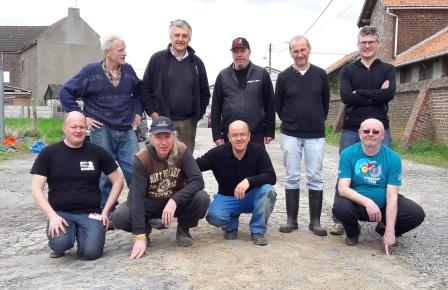
A likely bunch of lads. Francois is in the middle, front row. Top chap.
Francois had assembled a likely-looking bunch of French comrades for a bit of a working bee to keep the cobbles rideable. Our mission was to remove a short section of tarmac that had been laid over some pavé (quelle horreur! We must liberate the cobbles!), and to dig-up and re-lay a couple of spots where the cobbles had become impassably rough.
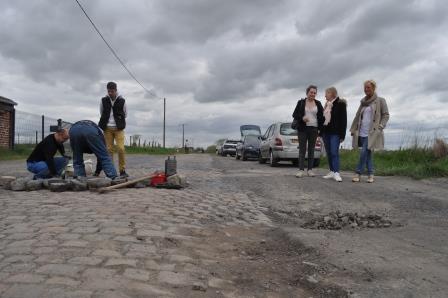
Cobbles maintenance: jobs for the boys?
Our 10-man work party was exactly as you might imagine. A handful of passionate French and Belgian cycling fans, a veritable Dads’ Army of cobblestone maintenance. These guys know their stuff. They all knew about the kiwi pros that have ridden Roubaix in recent years, and were interested to know what I thought of their prospects for this year’s race.
We went about our work at a gentle rate, and were interrupted from time to time by groups of kindred spirits riding through on their own Roubaix pilgrimage. I was pleased to hear a kiwi twang to one of the voices as they rode past, and caught up with a guy who comes over from his adopted home in Ireland to ride the cobbles every year. Small world.
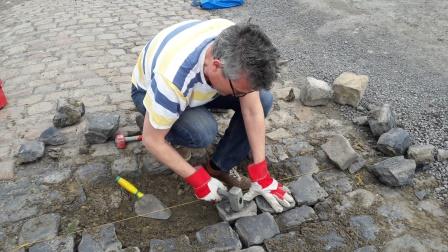
Gently…
Most of the pilgrims wanted to stop and pick up a stone. Partly to feel its weight, but also to try and recreate their own Rounbaix podium moment when the winner lifts a cobblestone trophy above his head to celebrate the win. Not all can manage it – the stones are heavy, and cyclists tend to have spindly arms, weakened further from hours of jack-hammer pave riding.
We’ve had a few kiwis racing the Paris-Roubaix over the years. It’s a rite of passage in the pro peloton; a right that has to be earned, as well as a test that riders aspire to taking. In recent years, several kiwis have even ridden in support of the eventual winner – Hayden Roulston and Jesse Sargeant riding for Fabian Cancellara in 2013, and Sam Bewley riding for Mathew Hayman last year. So we have a small but constant history.
At the Tour de France, it’s common that fans will paint the name of their favoured rider across the road, particularly on the tough mountain stages. That’s harder to do that on a cobbled farm track. I wanted to do something similar, so I had to get a bit creative to pay homage to the New Zealand Roubaix connection. I had a small metal kiwi, and took the chance to bury it beneath one of the cobbles as I was working. A small totem to say “chapeau!” to the kiwis that have passed before, and a “bon courage!” to those coming next.
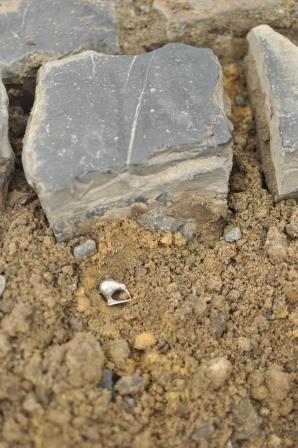
A kiwi in the cobbles
My afternoon working with Les Amis de Paris Roubaix was a delight. Their English was slightly better than my French, so communication was mostly in the universal language of blokes watching each other dig holes and then fill them back in again. Afterwards, we headed to the pub for a few beers. I was faced with the dilemma; French or Belgian? My decision to have one of each meant I needed to hop on my bike for a brief ride over the cobbles before driving back to Paris. It may also have meant that I got a bit carried away, and paid for both rounds. I can’t be 100% sure.
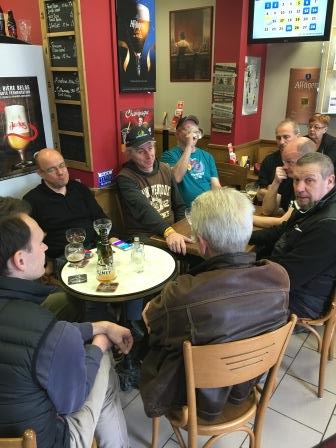
Beer. French or Belgian? Why not one of each?
What’s it like to ride on the Roubaix cobbles? I’m not going to lie. It’s tough. They’re big, widely spaced, and uneven. Less hard on the backside than I expected, but much harder on the arms. As soon as you hit the pave, you lose about 10 km of speed, and it’s hard to keep a good rhythm. I asked the experts for their advice: “Ride on the tops of the cobbles, it’s less muddy!” said one. “Ride in the wheel tracks, it’s smoother!” said another. “Pedal a big gear, you bounce too much otherwise!” “Keep the pedals spinning; it’s important to keep your rhythm”. So basically, do whatever feels right.
As I rode through the French countryside toward a warm spring sunset, the fillings rattling from my teeth took nothing from the thought that while I’ll never race the Paris-Roubaix, I’ve at least made a small kiwi contribution to preserving its long and colourful history. Bon courage!
This is a Directors Cut version of an article that will be published in the next issue of New Zealand Road Cyclist [www.nzroadcyclist.co.nz]. These guys do a great job of publishing and supporting road cycling in New Zealand in all forms. Go check them out or, better yet, subscribe to the magazine.
You can also read about my experience riding the Paris Roubaix sportive here.
Pingback: WW100: Honouring the New Zealand Cyclists Corps | Thousandth fastest